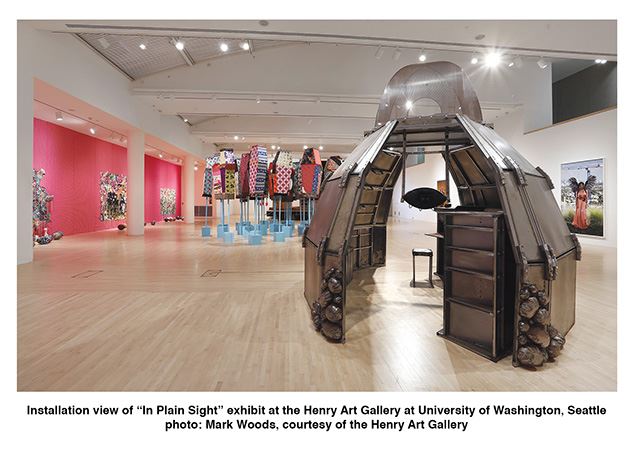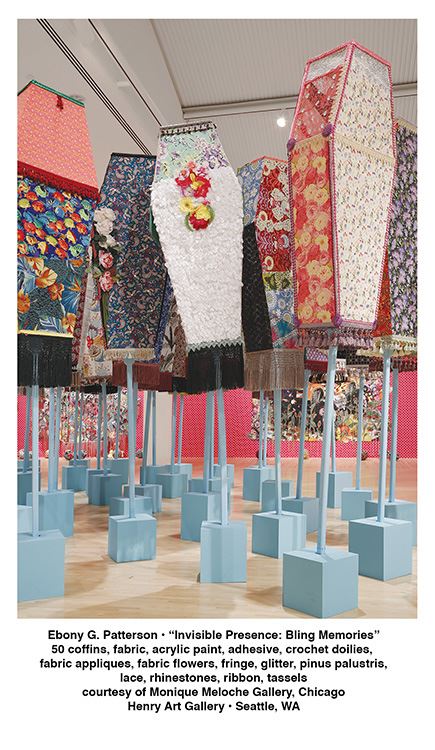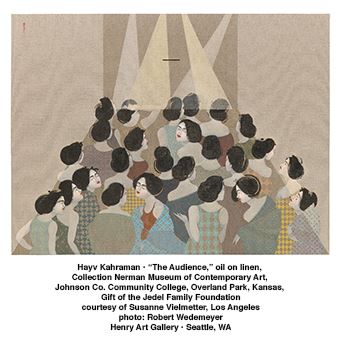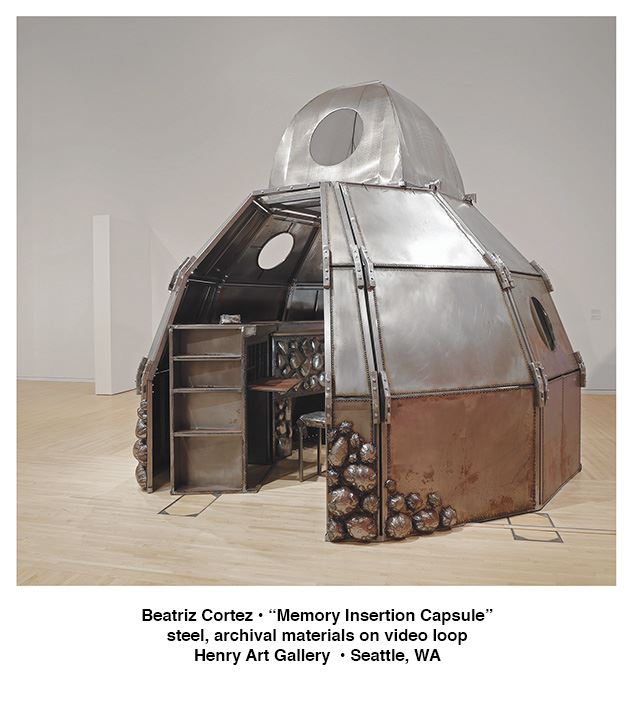
 Fifty coffins by Ebony G. Patterson, decorated with fabric flowers, fringe, glitter, lace, rhinestones, ribbon, and tassels stand in a dense cluster in the center of the Henry Art Gallery. Glorious to look at, “Invisible Presence: Bling Memories,” celebrates as well as mourns. The coffins bear witness to the lives of youths killed in violence during only four weeks. At the same time, in the tradition of Carnival, they suggest a celebration. Patterson amplifies that with three almost mural scaled collages that celebrate with a dense pattern of toys and, on the floor, paper-mâché balloons, the hopes and joys of youth who die young with titles like “…they were filled with hope, desire and beauty (…when they grow up…).”
Fifty coffins by Ebony G. Patterson, decorated with fabric flowers, fringe, glitter, lace, rhinestones, ribbon, and tassels stand in a dense cluster in the center of the Henry Art Gallery. Glorious to look at, “Invisible Presence: Bling Memories,” celebrates as well as mourns. The coffins bear witness to the lives of youths killed in violence during only four weeks. At the same time, in the tradition of Carnival, they suggest a celebration. Patterson amplifies that with three almost mural scaled collages that celebrate with a dense pattern of toys and, on the floor, paper-mâché balloons, the hopes and joys of youth who die young with titles like “…they were filled with hope, desire and beauty (…when they grow up…).”
Nearby we mount a large platform with several bookcases, part of Oscar Tuazon’s installation based on his continuing “Water School” project adapted to each locale where he shows it. For this installation, he included large maps of the rivers of the Olympic Peninsula and Lake Washington, highlighting the native names of rivers and omitting roads. His work, both visionary and historical, encourages us to think about water on indigenous land and the colonialism of dams, pipelines and other abuses.
These two impressive works are part of “In Plain Sight,” the first large exhibition by Senior Curator Shamim M. Momin. The exhibit features fourteen national and international artists whom we have not seen in Seattle. It fills the entire Henry Art Gallery with artists who address topics, communities, and stories not usually visible in public spaces. The exhibition gives us the opportunity to see artists with a sharp critical edge as they expose untold narratives.
 For example, Sadie Barnette’s moving installation “Room to Live” features the story of her father, Rodney Barnette, who was an active, but little-known, Black Panther, under extensive FBI surveillance. She juxtaposes redacted pages of his FBI file with a living room setting from the sixties, suggesting his personal life. Sanford Biggers’ combination of sculpture and textile mixed media wall pieces also forces us to rethink racial clichés and news bites. The bronze sculpture “BAM (for Michael)” confronted us in the stately museum medium, here pockmarked and damaged, with the reality of police violence.
For example, Sadie Barnette’s moving installation “Room to Live” features the story of her father, Rodney Barnette, who was an active, but little-known, Black Panther, under extensive FBI surveillance. She juxtaposes redacted pages of his FBI file with a living room setting from the sixties, suggesting his personal life. Sanford Biggers’ combination of sculpture and textile mixed media wall pieces also forces us to rethink racial clichés and news bites. The bronze sculpture “BAM (for Michael)” confronted us in the stately museum medium, here pockmarked and damaged, with the reality of police violence.
Tom Burr’s installations throughout the exhibition, quietly written in corners, list the names of locations he cut out of “Spartacus,” an International Gay Guide, for gay men to meet up. The piece originally conceived in 1989 and recreated for this show is all the more affecting for its subtlety.
 Hayv Kahraman’s dramatically scaled paintings would seem more straightforward than Burr’s lists of street names, but in fact they are equally layered with meanings that are hard to immediately grasp. Kahraman fled her native Iraq as a child in 1991 to escape Saddam Hussein’s brutal policies toward Kurds. But her paintings feature ironic statements on international entertainment fundraisers that stereotype victims as they raise money. She “orientalizes” the women she depicts, rendering them all alike as “other” as seen by Westerners.
Hayv Kahraman’s dramatically scaled paintings would seem more straightforward than Burr’s lists of street names, but in fact they are equally layered with meanings that are hard to immediately grasp. Kahraman fled her native Iraq as a child in 1991 to escape Saddam Hussein’s brutal policies toward Kurds. But her paintings feature ironic statements on international entertainment fundraisers that stereotype victims as they raise money. She “orientalizes” the women she depicts, rendering them all alike as “other” as seen by Westerners.
Beatriz Cortez of El Salvador created an intense steel portal honoring the 1000 men, women and children in El Mozote, brutally massacred in 1981 during the Civil War. In a corner of the gallery, she spoke the names of each victim layered over one another. We cannot understand the names, just as we cannot grasp the tragedy.
Alison O’Daniel addresses hearing loss and alternative means of communication through a series of videos called “The Tuba Thieves.” Based on an actual event in which tubas were stolen from a South Los Angeles marching band, stealing a crucial sound, she creatively conveys the difficulty of communication for the hard of hearing.
“In Plain Sight” requires time to experience, particularly for the video works. It is easy to miss Mika Rottenberg’s “Cosmic Generator” at the end of the exhibition in a very dark room, too dark to read the explanation. Rottenberg swerves between surrealism and narrative, documentary and pop to explore artificially created boundaries. Filmed in a Chinese restaurant in Mexico and a kitsch souvenir shop in China, the larger theme is the corruption of capitalism. Amusing scenes underscore that in wildly unpredictable imagery like a taco with men in suits lying inside.
The exhibition provides an opportunity to see a provocative range of very current artists who address the difficult topic of hidden stories for the ironically titled “In Plain Sight.” Thanks to Shamim M. Momin for bringing these challenging artists to Seattle.
Susan Noyes Platt
Susan Noyes Platt writes a blog www.artandpoliticsnow.com and for local, national, and international publications.
“In Plain Sight” is on view at the University of Washington’s Henry Art Gallery, located at 5th Avenue NE & NE 41st Street in Seattle, Washington. The hours are Wednesday, Friday, Saturday, and Sunday from 11 A.M. to 4 P.M. and Thursday 11 A.M. to 9 P.M. For more information, visit www.henryart.org.